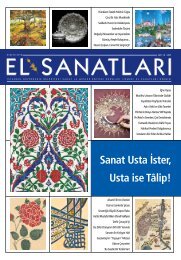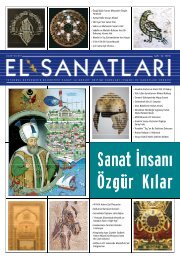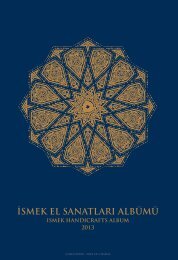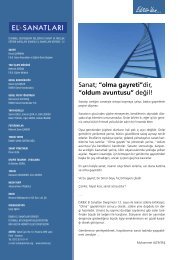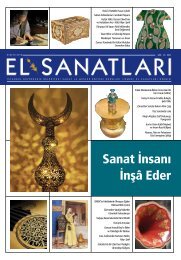Download Link - Ä°SMEK
Download Link - Ä°SMEK
Download Link - Ä°SMEK
You also want an ePaper? Increase the reach of your titles
YUMPU automatically turns print PDFs into web optimized ePapers that Google loves.
Throughout two centuries of existence, the Anatolian Seljuk State managed to produce very significant<br />
works of art. It is noticed in the Seljuk architecture that architectural elements are ornamented in many<br />
different ways. In ornaments that calligraphy and floral patterns were used together calligraphy comes<br />
to the foreground, or that geometrical and floral ones were used together geometrical ornament<br />
is seen in the foreground. Here, we studied the usage of the rumi pattern in arrangement of portal<br />
ornament of the structures in the Anatolian Seljuk architecture in a chronological order.<br />
Muslims endeavoured to break the strength of the Christian<br />
Byzantine Empire in Anatolia by fighting for centuries, yet<br />
they couldn't manage. This strength was broken by the victory<br />
that Alp Arslan the Great Seljuk Sultan had won in the<br />
Battle of Manzikert in 1071, 1 and that set a homeland in<br />
Anatolia for the migrating Turkmen. Thus Turkmen started<br />
to immigrate in groups. 2 By help of the political impotency<br />
that Byzantium fell into after the Manzikert defeat, Alp Arslan's<br />
cousins, Qutulmish, took Isnikea in Malik-Shah's period<br />
without encountering a serious resistance in the region in<br />
1075. They used it as a base and laid the foundations of the<br />
Anatolian Seljuk State. 3 However, Suleyman Shah's expansion<br />
policy over northern Syria and the siege of Aleppo were<br />
taken as a danger by the Great Seljuk and a countermove<br />
was taken in turn. After the death of Suleyman Shah, his<br />
sons Kilij Arslan and Dolat were brought to Malik-Shah.<br />
Freed by the death of Malik-Shah in 1092, Kilij Arslan, went<br />
to Isnikea and there came into power. 4 Kilij Arslan the First<br />
couldn't stop the First Crusade from taking over Isnikea in<br />
1096 5 and he directed his expansion policy towards the<br />
East because of the agreement he had made with Byzantine<br />
Empire therefore the capital was moved to Konya. 6 The<br />
Anatolian Seljuk State, that got on the stage of history, constituted<br />
a political unity in Anatolia by patroning the other<br />
principalities around them. Despite the fights for the throne<br />
after every death of sultans, they managed to expand and<br />
become a wealthy state. They lived the golden age in the<br />
periods of Kaykaus the 1 st (1211-1220) 7 and Kayqubad the 1st<br />
(1220-1237). 8 On 3 July 1243 in a skirmish with Mongolians<br />
in Kose Dag, Anatolian Seljuk Army were defeated without<br />
showing a good defence in the period of Kaykhusraw the<br />
2nd. 9 After this battle the Anatolian Seljuk State paid high<br />
taxes to Mongolians and could only maintain dependent to<br />
them. The state which managed to maintain by the help of<br />
powerful viziers like Celaleddin Karatay and Sahib Ata Fakhr<br />
al-Din Ali could survive some more time after them. 10<br />
Because of the Seljuk Sultans' not being independent, principalities<br />
like Karamanids and Eshrefids revolted. Invasions,<br />
revolts and civil wars caused the order in Anatolia to be broken,<br />
heavy taxes and pillages of Mongolians brought poverty<br />
throughout the land. 11 All of these brought Seljuk Dynasty<br />
Ulu Mosque in Diyarbakir



